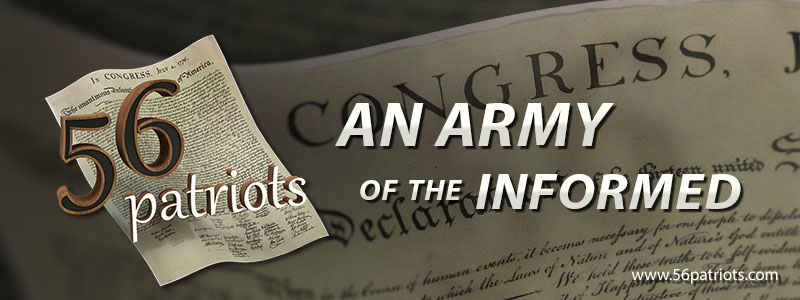Publisher's note: This post, by Donald Bryson, was originally published in Civitas's online edition.
When the American people were debating whether to adopt our Constitution, North Carolina (a hotbed of anti-federalism) took the lead in ensuring the document was amended to include a bill of rights. Today North Carolina can lead once more by joining the movement for constitutional amendments correcting our dysfunctional and abusive federal government.
Most Americans favor term limits on members of Congress and federal judges. Most support curbs on excessive deficit spending. Most seek a smaller federal government. But Congress refuses to adopt any of these reforms. By joining with her sister states, North Carolina can help trigger what the Constitution calls a
"convention for proposing amendments." That is a gathering of representatives chosen by the state legislatures and empowered to propose reforms that Congress refuses to adopt.
This is the story of how, during the Founding Era, North Carolina helped force the adoption of a federal bill of rights. And it did so, in part, by suggesting an amendments convention.
The Constitutional Convention - It didn't happen the way you may have been told.
In 1786 the United States had no Constitution. The states were held together by the
Articles of Confederation-essentially a treaty among sovereigns somewhat like NATO. The system wasn't working well.
Late that year, a "convention of states" meeting in
Annapolis, Maryland, suggested that the states meet again in convention the following May to consider changes in the political system. As a result of this recommendation, Virginia invited the states to meet in Philadelphia the following May. Contrary to a common misconception, this meeting was not initiated by Congress for amending the Articles of Confederation, but by the states for
"devising and discussing all such Alterations and Provisions as may be necessary to render the Federal Constitution adequate to the Exigencies of the Union..." (During the founding era, the word "constitution" meant the entire political system.)
Eventually, 12 of the 13 states attended the Convention. For several months, the delegates drafted a proposed Constitution.
Article V
The delegates were justifiably proud of their work, but they recognized that changes might be necessary from time to time: Conditions might alter. The document might be misinterpreted, requiring corrections. Unforeseen abuses might arise. So they added
Article V to the document outlining procedures for amendment.
An early draft vested the power to propose amendments entirely in Congress. But on September 15, 1787, as the Convention drew to a close, Col. George Mason of Virginia rose to address what he saw as a fatal flaw in this plan. According to James Madison's notes, Mason
"thought the plan of amending the Constitution exceptionable and dangerous." "If Congress enjoyed the sole power to propose amendments," he reasoned,
"no amendments of the proper kind would ever be obtained by the people, if the Government should become oppressive," as he verily believed would be the case.
And so, under the final version of Article V adopted unanimously by the Convention, either Congress or the states (in a meeting called a "convention") may propose amendments. A convention for proposing amendments is a "convention of the states"-a frequent kind of gathering used before, during, and after the Founding. (The latest was in Phoenix, Arizona in 2017.) Regardless of how they are proposed, all amendments must be ratified by three-fourths of the states (now 38).
On September 17, 1787, the Philadelphia convention adjourned and released the draft Constitution to the public. The Constitution would become effective only if popularly-elected conventions meeting in at least nine states ratified it. The result was a huge national debate. Some states-such as Delaware and New Jersey-were so enthusiastic about the Constitution that they approved it virtually without question. But North Carolinians were more cautious and thoughtful.
North Carolinians and ratification
The attitudes of North Carolinians became evident once the
state convention gathered in Hillsborough on July 21, 1788, to consider the Constitution. North Carolinians wanted to be part of the United States, and many of its citizens liked the Constitution. But they thought some necessary protections were absent.
They had two principal concerns. First, they worried that the document did not adequately protect individual rights. As Delegate Samuel Spencer told his colleagues:
- There is no declaration of rights, to secure to every member of the society those unalienable rights which ought not to be given up to any government. Such a bill of rights would be a check upon men in power . . . . There ought to be a bill of rights, in order that those in power may not step over the boundary between the powers of government and the rights of the people, which they may do when there is nothing to prevent them.
Second, they were concerned that the federal government would become too big, too powerful, and too arbitrary-thereby threatening the ability of North Carolinians to govern themselves in local matters. (This concern was not primarily driven by slavery because slave owners were a minority in North Carolina.)
The Constitution's advocates thought the document contained enough protections. Thus, Governor Samuel Johnston pointed out that
"The powers of Congress are all circumscribed, defined, and clearly laid down. So far they may go, but no farther."
But most delegates were not so sure. For example, Joseph Taylor told his convention colleagues that the Constitution appeared to create
"a consolidation of all the states . . . . Will any gentleman say that a consolidated government will answer this country? It is too large." And Samuel Spencer agreed:
"I can see no power that can keep up the little remains of the power of the states. Our rights are not guarded."
Earlier, some critics of the Constitution had urged that it be re-written before any states ratified it. But when the North Carolina delegates met, the requisite nine states already had ratified. The Constitution was going into effect, no matter what North Carolina did. So how could North Carolina assure that the Constitution was amended to protect the states and the people?
But they had an ace in the hole: North Carolina could refuse to join the Union until amendments were proposed. North Carolina was not a populous state, but it was a large one, and if it stayed out of the Union, the United States would be severed in two. This action would encourage other states to seek the protective amendments North Carolina wanted.
Though, most other states didn't need encouragement. Many of the state conventions that had ratified the Constitution already had suggested amendments. Virginia and New York went further: both submitted applications (demands) for an amendments convention. In other words, the states were saying that if Congress didn't propose a bill of rights, they would do the job themselves.
On August 1, 1788, the North Carolina convention passed a
resolution listing the amendments it wanted. They included most of the basic protections we enjoy today. The North Carolina amendments also included one protecting state powers.
The convention resolution asked that Congress or a "Convention of the States" consider those amendments. After adopting this resolution, the convention temporarily adjourned without ratifying the Constitution.
North Carolina's tactic worked. On June 8, 1789, Representative James Madison rose in the new federal Congress to introduce a bill of rights, and Congress formally
proposed an amended version of Madison's bill on March 4, 1789. The final form of the Bill of Rights included much of what North Carolina demanded: freedom of speech, freedom of religion, due process of law, trial by jury, protection for the states, and more.
Having won this victory, the North Carolina convention
re-assembled in Fayetteville and overwhelmingly ratified the Constitution.
Why this history matters today
In some ways, the situation facing us today is similar to that of 1788-89. We have a good Constitution, but some things are not quite right. History shows that one way to correct them is by constitutional amendment.
But just as the Founders predicted, Congress has refused to propose necessary amendments-in other words, Congress refuses to reform itself. That's why states like North Carolina should take the lead.
States can do this by adopting legislative resolutions ("applications") for a convention for proposing amendments-just as Virginia and New York did-and just as North Carolina suggested-back in 1788-89.
Although several groups are sponsoring form applications, the best is that promoted by the
Convention of States Project. It would empower a convention to propose amendments to reduce the size and scope of the federal government, control its overspending, and adopt term limits. The convention could not consider any items outside of those areas, and any attempt to do so would be ruled "out of order."
Responding to objections
Naturally, any suggestion for reforming our federal government will encounter push back from the nation's political, media, and academic elite - as has happened many times before.
The most dramatic example occurred in the 1970s when the states very nearly triggered a convention to address overspending and Supreme Court overreach. Establishment
professors, politicians, and
media were determined to scare people away from a convention. They claimed the convention would not be controllable. They claimed there was no established law governing the amendment process. They even asserted that a convention for proposing amendments would be a "constitutional convention" that could, essentially, stage a
coup d'etat.
Those charges were not countered effectively, and even some would-be reformers were terrified by them. The states pulled back.
Today, however, we know protests to an amendment convention were wildly exaggerated. The truth is that, as the Supreme Court has said, a
"convention for proposing amendments" is nothing but a
"convention of the states"-a
very common kind of meeting in American history whose procedures and protocols are well known.
The claim that there is no law governing Article V also was false. In 2018, a legal scholar produced an
entire book on Article V law, outlining the many decided cases and precedents governing the amendment process.
North Carolina was right to promote an amendments convention in 1788, and it would be right to do so today. Our legislature can kick-start the process by approving the application sponsored by the Convention of States Project.























